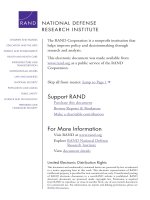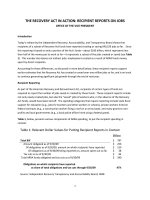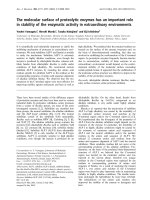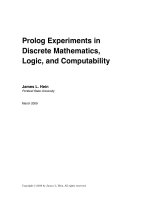Networked Forces in Stability Operations - 101st Airborne Division, pdf
Bạn đang xem bản rút gọn của tài liệu. Xem và tải ngay bản đầy đủ của tài liệu tại đây (2.53 MB, 222 trang )
This document and trademark(s) contained herein are protected by law as indicated in a
notice appearing later in this work. This electronic representation of RAND intellectual
property is provided for non-commercial use only. Unauthorized posting of RAND PDFs
to a non-RAND Web site is prohibited. RAND PDFs are protected under copyright law.
Permission is required from RAND to reproduce, or reuse in another form, any of our research
documents for commercial use. For information on reprint and linking permissions, please
see RAND Permissions.
Limited Electronic Distribution Rights
Visit RAND at www.rand.org
Explore RAND National Defense Research Institute
View document details
For More Information
Purchase this document
Browse Books & Publications
Make a charitable contribution
Support RAND
This PDF document was made available from www.rand.org as
a public service of the RAND Corporation.
6
Jump down to document
The RAND Corporation is a nonprofit research
organization providing objective analysis and
effective solutions that address the challenges facing
the public and private sectors around the world.
THE ARTS
CHILD POLICY
CIVIL JUSTICE
EDUCATION
ENERGY AND ENVIRONMENT
HEALTH AND HEALTH CARE
INTERNATIONAL AFFAIRS
NATIONAL SECURITY
POPULATION AND AGING
PUBLIC SAFETY
SCIENCE AND TECHNOLOGY
SUBSTANCE ABUSE
TERRORISM AND
HOMELAND SECURITY
TRANSPORTATION AND
INFRASTRUCTURE
WORKFORCE AND WORKPLACE
This product is part of the RAND Corporation monograph series. RAND
monographs present major research findings that address the challenges facing
the public and private sectors. All RAND monographs undergo rigorous peer
review to ensure high standards for research quality and objectivity.
Networked Forces in
Stability Operations
101st Airborne Division,
3/2 and 1/25 Stryker Brigades
in Northern Iraq
Daniel Gonzales, John Hollywood, Jerry M. Sollinger, James McFadden,
John DeJarnette, Sarah Harting, Donald Temple
NATIONAL DEFENSE RESEARCH INSTITUTE
Prepared for the Office of the Secretary of Defense
Approved for public release; distribution unlimited
The RAND Corporation is a nonprofit research organization providing objective analysis and
effective solutions that address the challenges facing the public and private sectors around the world.
RAND’s publications do not necessarily reflect the opinions of its research clients and sponsors.
R
®
is a registered trademark.
© Copyright 2007 RAND Corporation
All rights reserved. No part of this book may be reproduced in any form by any electronic or
mechanical means (including photocopying, recording, or information storage and retrieval) without
permission in writing from RAND.
Published 2007 by the RAND Corporation
1776 Main Street, P.O. Box 2138, Santa Monica, CA 90407-2138
1200 South Hayes Street, Arlington, VA 22202-5050
4570 Fifth Avenue, Suite 600, Pittsburgh, PA 15213-2665
RAND URL:
To order RAND documents or to obtain additional information, contact
Distribution Services: Telephone: (310) 451-7002;
Fax: (310) 451-6915; Email:
The research described in this report was prepared for the Office of the Secretary of Defense (OSD).
The research was conducted in the RAND National Defense Research Institute, a federally funded
research and development center sponsored by the OSD, the Joint Staff, the Unified Combatant
Commands, the Department of the Navy, the Marine Corps, the defense agencies, and the defense
Intelligence Community under Contract DASW01-01-C-0004.
Library of Congress Cataloging-in-Publication Data
Networked forces in stability operations : 101st Airborne Division, 3/2 and 1/25 Stryker
brigades in northern Iraq / Daniel Gonzales [et al.].
p. cm.
Includes bibliographical references.
ISBN 978-0-8330-4303-0 (pbk. : alk. paper)
1. Command and control systems—United States—Evaluation—Case studies.
2. Communications, Military—Evaluation—Case studies. 3. Stryker brigade
combat teams—Evaluation—Case studies. 4. United States. Army. Airborne
Division, 101st—History—21st century. 5. United States—Armed Forces—Stability
operations—Evaluation. 6. Iraq War, 2003–—Campaigns. I. Gonzales, Daniel,
1956–
UA943.N48 2007
956.7044'342—dc22
2007041879
Public release of this report was granted by the Chief of the DoD Office of Security Review
on 17 September 2007, per DD Form 1910.
iii
Preface
is case study report examines the network-centric operations (NCO) capabilities
and the operations of Stryker brigades and the 101st Airborne Division that conducted
stability operations in Iraq in the 2003 to 2005 time frame. We investigate how the
NCO capabilities and other resources available to these units were utilized to conduct
stability and counterinsurgency operations and whether these capabilities resulted in
improved mission effectiveness.
e monograph should interest U.S. Army and joint task force designers, those
concerned with the development of digital battle command and communications sys-
tems, and those interested in the implications of NCO for the transformation of mili-
tary forces.
is research was sponsored by the Office of Force Transformation and con-
ducted within the Acquisition and Technology Policy Center of the RAND National
Defense Research Institute, a federally funded research and development center spon-
sored by the Office of the Secretary of Defense, the Joint Staff, the unified combatant
commands, the Department of the Navy, the Marine Corps, the defense agencies, and
the defense Intelligence Community.
For more information on RAND’s Acquisition and Technology Policy
Center, contact the director, Philip Antón. He can be reached by email, Philip_Anton@
rand.org; by phone at 310-393-0411, ext. 7798; or by mail at RAND, 1776 Main Street,
Santa Monica, California, 90407-2138. More information about RAND is available at
www.rand.org.
v
Contents
Preface iii
Figures
ix
Tables
xi
Summary
xiii
Acknowledgments
xxxv
Abbreviations
xxxvii
CHAPTER ONE
Introduction 1
Background
1
Objectives
3
Analytic Approach
4
Sources of Information
9
Organization of Monograph
10
CHAPTER TWO
Iraqi Operational Setting and Unit Characteristics 13
Characteristics of Anti-Iraqi Forces
16
Phases of the Insurgency
17
Unit Organization
18
Areas of Operation
20
AO Sizes, Personnel, Funding, and Attached Units
23
Timeline of Events
28
U.S. Casualties
36
CHAPTER THREE
Force Networking, Quality of Information, and Quality of Shared Situation
Awareness
39
Networking Systems
39
Effect of Networking Systems on Quality of Information
48
Specific Effects of Networking Systems on Quality of Information
54
Effect of Networking Systems on Quality of Collaboration
56
Quality of Shared Situation Awareness
58
CHAPTER FOUR
Tactical Stability Missions, NCO-Enabled Processes, and Tactical Mission
Effectiveness
65
Tactical Military Operations in Stability Operations
65
NCO-Enabled Processes
68
Speed and Agility of Command
69
Responsive Maneuver
72
Networking with Aerial Support and Surveillance Assets
74
Robustness to Enemy Attack
75
Stability Operations Intelligence Needs
91
CHAPTER FIVE
Mission Effectiveness in Stability Operations 95
U.S. Strategic Objectives and MNF–I Campaign Plan
95
Assessment Framework
98
Assessment of Effectiveness—Political Progress
101
Assessment of Effectiveness—Defeating Terrorists and Containing the Insurgency
108
Summary of Mission Effectiveness
123
CHAPTER SIX
Summary: Findings and Recommendations 129
Assessment of 101st ABD Mission Effectiveness in Stability Operations
129
Assessment of 3/2 SBCT Mission Effectiveness in Stability Operations
133
Assessment of 1/25 SBCT Mission Effectiveness in Stability Operations
136
Role of NCO Capabilities in Improving Force Effectiveness in Stability Operations
139
Summary of Network and Intelligence Capabilities
142
vi Networked Forces in Stability Operations: 101st ABD, 3/2 and 1/25 SBCTs in Northern Iraq
Additional Findings 144
Recommendations
145
APPENDIX
A. Director, Office of Force Transformation, Study Authorization Memorandum 147
B. SBCT Tactics, Techniques, and Procedures Used in OIF
151
C. Detailed Results of the Quality of Information and Collaboration Surveys
161
D. Iraqi National Elections
165
Bibliography
171
Contents vii
ix
Figures
S.1. Civilians Killed in All of Iraq and in Mosul xv
S.2. U.S. Personnel Killed and Wounded in Action per Enemy Attack
xvi
S.3. U.S. Personnel Killed and Wounded in Action per Offensive Operation
xvi
S.4. Key Factors Influencing 101st ABD Performance in Stability Operations
xviii
S.5. Key Factors Influencing 3/2 SBCT Performance in Stability Operations
xxii
S.6. Key Factors Influencing 1/25 SBCT Performance in Stability Operations
xxv
S.7. Adaptation of Materiel and Nonmateriel NCO Force Elements
xxix
1.1. NCO Conceptual Framework
6
1.2. NCO Analysis Approach
8
2.1. e “Sunni Triangle” and U.S. Unit Operating Areas
14
2.2. Locations of Frequent U.S. Military Casualties Between May 2003 and July
2005
15
2.3.
101st ABD, 3/2 SBCT, and 1/25 SBCT Organizational Structures
19
2.4. 101st ABD and 3/2 SBCT Area of Operations
21
2.5. e 1/25 SBCT Area of Operations
22
2.6. Causes of Death for U.S. Troops
31
2.7. U.S. Military Casualties in OIF since March 19, 2003
37
3.1. 101st ABD Infantry Brigade Network
40
3.2. 3/2 SBCT Communications Network
42
3.3. IKSS Network
44
3.4. UAV Imagery Received by Rover III
45
3.5. Predator Control Using Rover III and SIPRNET MIRC
46
3.6. C2/BC Systems
47
3.7. Quality of Information for Cordon-and-Search and Knock-and-Raid
Missions
52
3.8
. Quality of Information for Convoy Missions 53
3.9. Survey Results on Quality of Collaboration
57
x Networked Forces in Stability Operations: 101st ABD, 3/2 and 1/25 SBCTs in Northern Iraq
4.1. Timeline for Major Operations in Northern Iraq 68
4.2. An Order-of-Magnitude Increase in Speed and Agility of Command
70
4.3. SBCT Task Force’s Movement to Najaf
73
4.4. Map of Mogadishu and Initial Position of Assault Forces
78
4.5.
Timeline of the Battle of Mogadishu
80
4.6. Timeline for the Tal Afar Incident
85
5.1. Multi-National Forces–Iraq Campaign Plan
97
5.2. Enemy Attacks—eaterwide and in AO North
110
5.3. Percentage Change in Enemy Attacks During Each Unit’s Rotation 111
5.4. Civilian KIAs for All of Iraq and for Mosul
112
5.5. Offensive Operations per Enemy Attack for the 101st ABD, 3/2 SBCT,
and 1/25 SBCT
117
5.6. U.S. KIA and WIA per Enemy Attack
118
5.7. U.S. KIA and WIA per Offensive Operation
118
5.8. Number of IEDs and Weapons Caches Found per Enemy Attack for the
101st ABD, 3/2 SBCT, and 1/25 SBCT
122
5.9.
Influence of Network-Enabled Capabilities on Stability Operations
126
6.1.
Key Factors Influencing 101st ABD Performance in Stability Operations
130
6.2. Key Factors Influencing 3/2 SBCT Performance in Stability Operations
134
6.3. Key Factors Influencing 1/25 SBCT Performance in Stability Operations
137
6.4. Adaptation of Materiel and Nonmateriel NCO Force Elements
141
B.1. Cover of the 1/25 SBCT’s Leaders Agility Book
152
C.1. Detailed Quality of Information Results for Cordon-and-Search/
Knock-and-Raid Operations
162
C.2. Detailed Quality of Information Results for Convoy Operations
163
C.3. Detailed Quality of Collaboration and Shared Situation Awareness
Results
164
D.1. Iraqi National Election System for the Constitutional Referendum
166
D.2. Results of the Iraqi Constitutional Referendum
168
xi
Tables
S.1. U.S. Stability Objectives xiv
S.2. Summary of SBCT Networking and Battle Command Enhancements
xxx
2.1.
Unit Areas of Operation, Resident Iraqi Populations, U.S. Troop Levels,
and Attached ING Units
24
3.1. NCO Enhancements in Northern Iraq
49
3.2. Breakdown of Survey Responses by Rank and Unit Role
51
3.3. Summary of Units’ Shared Situation Awareness
63
4.1. Battle of Mogadishu Total Mission Casualties
83
4.2. Battle of Tal Afar Total Mission Casualties
88
4.3.
Forces Employed in the Battle of Tal Afar and Mogadishu
90
5.1. U.S. Strategic Goals in Iraq
96
5.2. Political Goal Assessment Measures
98
5.3. Security Goal Assessment Measures
100
5.4. Summary of Political Progress Assessment for 101st ABD
101
5.5. Summary of Political Progress Assessment for 3/2 SBCT
103
5.6.
Summary of Political Progress Assessment for 1/25 SBCT
106
5.7. Casualty Rates for the 101st ABD and 3/2 SBCT
116
5.8. Mission Effectiveness Assessment Summary
124
6.1. Summary of Networking and Battle Command Enhancements
143
xiii
Summary
Background
e Stryker brigade, one of the Army’s newest units, has advanced command, con-
trol, and intelligence capabilities and uses a network-centric concept of operations.
ese capabilities include the full complement of Army digital communications and
battle command systems. Its networked capabilities enabled it to employ network-cen-
tric operations (NCO) capabilities down to a lower echelon than other Army units.
An important issue for the Department of Defense and the Army is whether these
improved capabilities translate into an information advantage and, if so, whether that
advantage results in greater mission effectiveness in stability operations.
Purpose and Approach
is study attempts to answer those two questions by focusing on the Stryker brigade’s
performance in stability operations. It employs the case-study methodology to examine
three units that operated in the same area in Iraq between 2003 and 2005: the 101st
Airborne Division (ABD), the 3/2 Stryker brigade combat team (SBCT), and the 1/25
SBCT. All served in Iraq’s northern provinces. e study compares the performance
of the units along a number of dimensions. e comparisons between the 101st ABD
and the Stryker brigades are especially important because, although the 101st ABD
had some advanced battle command systems, it was largely an “analog” unit, i.e., one
that communicated using analog radios and generally used voice-only, line-of-sight
communications at the tactical level. In many respects, the units of the 101st ABD
closely resemble light infantry brigades. In contrast to the 101st ABD, Stryker units
had networked digital communications networks and access to high-capacity satellite
xiv Networked Forces in Stability Operations: 101st ABD, 3/2 and 1/25 SBCTs in Northern Iraq
communications at lower echelons, which enabled them to communicate even when
units did not have line of sight between them.
We recognize the issues inherent in the methodology and in the specific com-
parisons we make. Case studies are essentially qualitative comparisons, although they
can be informed by quantitative information. Additionally, they are analogies because
in real-world operations the cases are not identical. We also recognize that the situ-
ations confronting the three units differed substantially, even though all three units
operated in the same provinces in Iraq. e 101st ABD was there shortly after major
combat operations (MCO) concluded but before the insurgency had hit full stride.
Furthermore, the two Stryker brigades did not have identical sets of equipment. e
1/25 SBCT had more enhanced communications and intelligence capabilities than
did the 3/2 SBCT. at said, we believe that the methodology can shed light on the
performance of the two types of units and on how network-centric capabilities affect
unit performance.
We use two of the four U.S. objectives for stability and reconstruction in Iraq
(see Table S.1) to assess the mission effectiveness of stability operations undertaken by
each unit.
Table S.1
U.S. Stability Objectives
Security
Political
Defeating terrorists and containing insurgents
Forge a broadly supported national concept for democratic governance
Civilian Deaths
Figure S.1 plots reported civilians killed in action (KIAs) by month for all of Iraq and
for Mosul. As shown, the number of civilian KIAs per month surged in June 2004 and
remained roughly flat or increased slightly thereafter throughout Iraq as a whole. e
data indicate that there has not been any sustained reduction in civilian casualties in
Iraq overall after the peaks in February and August 2005.
Before we turn to a detailed examination of each unit’s performance, we look at
trends in civilian and U.S. casualties in Iraq and in northern Iraq.
Summary xv
Figure S.1
Civilians Killed in All of Iraq and in Mosul
0
50
100
150
200
250
Jun-03
Aug-03
Oct-03
Dec-03
Feb-04
Apr-04
Jun-04
Aug-04
Oct-04
Dec-04
Feb-05
Apr-05
Jun-05
Aug-05
Oct-05
Civilian deaths in Mosul area
0
500
1,000
1,500
2,000
2,500
Civlian deaths in all of Iraq
101st ABD 3/2 SBCT 1/25 SBCT
RAND MG593-S.1
All of Iraq Iraqi elections101st ABD 1/25 SBCT3/2 SBCT
Figure S.1 also plots reported civilian KIAs for Mosul and indicates when each
unit operated in Mosul and elsewhere in northern Iraq. In comparison with civilian
KIAs elsewhere in Iraq, civilian KIAs in Mosul fall off sharply after June 2005. is
pattern is consistent with reports that the 1/25 SBCT defeated a major insurgent offen-
sive in Mosul, captured key insurgent leaders, and disrupted insurgent operations.
U.S. Casualties Adjusted for Operational Tempo
Figures S.2 and S.3 show order-of-magnitude reductions in casualty rates for both
Stryker brigades relative to both the 101st ABD and other units in Iraq at the same
time, when operational intensity (both enemy and U.S.) factors are taken into account.
ese results reflect the growing intensity of Stryker brigade operations in response
to attacks as the insurgency grew over time. Note that the 1/25 SBCT casualty rates
xvi Networked Forces in Stability Operations: 101st ABD, 3/2 and 1/25 SBCTs in Northern Iraq
Figure S.2
U.S. Personnel Killed and Wounded in Action per Enemy Attack
Killed in action
Wounded in action
Mosul area All Iraq
0.00
0.02
0.04
0.06
0.08
0.10
0.12
0.00
0.10
0.20
0.30
0.40
0.50
0.60
0.70
101 ABD 3/2 SBCT 1/25 SBCT
101 ABD 3/2 SBCT 1/25 SBCT
Average number of
personnel
RAND MG593-S.2
Figure S.3
U.S. Personnel Killed and Wounded in Action per Offensive Operation
Killed in action
Wounded in action
Mosul area All Iraq
0.00
0.10
0.20
0.30
0.40
0.50
0.00
0.50
1.00
1.50
2.00
2.50
3.00
101 ABD 3/2 SBCT 1/25 SBCT
101 ABD 3/2 SBCT 1/25 SBCT
Average number of
personnel
RAND MG593-S.3
Summary xvii
(adjusted for operational tempo [OPTEMPO] and enemy attacks) are the lowest of all
units in Area of Operation (AO) North.
Our analysis of SBCT tactical defensive operations indicates the SBCT’s combined
materiel improvements (Force XXI Battle Command Brigade and Below (FBCB2) and
digital communications) and nonmateriel improvements (doctrine; tactics, techniques,
and procedures [TTPs]; training) led to significant improvements in blue force quality
of information and situation awareness. In some cases, the SBCTs were able to capital-
ize on improved blue force awareness to execute a number of advanced tactics, includ-
ing accelerated planning, dynamic force retasking, self-synchronization, and swarm-
ing, which in turn led to improvements in performing tactical defensive missions. e
SBCTs displayed a robust dynamic response to enemy ambushes and attacks.
e 1/25 SBCT also used these advanced tactics, new networked intelligence
capabilities, and decentralized operations to conduct targeted raids that enabled Stryker
units to respond quickly and effectively to intelligence tips. Further, these new intel-
ligence capabilities were integrated into the tactical capabilities of 1/25 SBCT units.
1
ese operations would not have been possible without the SBCTs’ information and
networking capabilities embedded at the tactical level.
2
Assessment of 101st ABD Mission Effectiveness
Figure S.4 summarizes the materiel and nonmateriel factors contributing to the perfor-
mance of the 101st ABD in Iraq. From a communications network technology perspec-
tive, the 101st ABD benefited from having FBCB2–Blue Force Tracking (FBCB2-BFT)
systems on some command and control (C2) vehicles and many helicopters (68 ground
systems and 88 aviation systems). e rest of its systems were the Army’s standard
issue—they relied on mobile subscriber equipment (MSE) and near-term digital radio
(NTDR) legacy equipment for communications and the All Source Analysis System
(ASAS) and other legacy systems for intelligence, surveillance, and reconnaissance.
1
See the classified annexes to this monograph for further details.
2
e conclusions we reach here are similar to those identified independently in Robert D. Kaplan, “e Coming
Normalcy?” e Atlantic Monthly, Vol. 297, No. 4, April 2006, pp. 72–81.
xviii Networked Forces in Stability Operations: 101st ABD, 3/2 and 1/25 SBCTs in Northern Iraq
Color legend
Worse
Better
Operational Performance
• Effective in patrols,
“soft raid” and
reconstruction
operations
• Established social
networks with Iraqi
populace and local
leaders
• Limited effectiveness
in HVT ops,
counter-infiltration
Mission Effectiveness
• Fairly high U.S.
casualties/event
• Number of attacks and
civilian casualties low
but increased over time
• Substantial insurgent
infiltration into Mosul
• Brought Sunni groups
into political process,
but arrangements
degraded over time
External Factors
• Disbanding of Iraqi
army and
de-Baathification leads
to riots
• Initial collapse of the
Mosul police
department (May 2003)
RAND MG593-S.4
Organization
• Force structure: air mobile
division—light infantry
supported by helicopters
• Resources: significant
reconstruction funding; three
engineering battalions; division
complements of chaplains, MPs,
and intelligence analysis and
HUMINT personnel
Information
• Blue: significant information
on units at battalion and
higher; limited information
on units below battalion
• Red and Green: limited,
with decreasing information
from the population
Process
• Used traditional planning cycles
to conduct offensive operations
• Emphasis on law enforcement–
like patrols and raids
• Worked with tribal leaders,
encouraged political dialog
• Infrastructure projects
People
• Training: focus on MCO-like operations
• Command agility: quick change in focus
from MCO to stability operations
• Commanders’ intent: focus on law
enforcement–like operations and civil
reconstruction
Technology
• ISR: ASAS and other legacy
systems, COTS applications
• FBCB2/BFT on some C2
vehicles and helicopters
• Communications: MSE
and NTDR legacy
equipment
Figure S.4
Key Factors Influencing 101st ABD Performance in Stability Operations
Summary xix
From an organizational perspective, the 101st ABD is as an air-mobile division,
comprising light infantry supported by helicopters, with about 17,000 troops total. In
comparison, the Iraqi province in which they operated most heavily, Ninawah, has a
population of about 2.5 million (with Mosul having a population of about 1.8 million),
for a total force ratio of about 6.8 soldiers per thousand residents; historically, this ratio
is at the edge of the force size needed to conduct a stability operation.
3
Note that this
force ratio does not include security forces that were hired, equipped, and trained by
U.S. forces (regional police and new Iraqi Army forces). We do not include these forces
in the force presence ratio for several reasons: First, their numbers could not be accu-
rately ascertained because they changed significantly from month to month. Second,
the reliability and experience of these forces varied significantly depending upon the
unit and the time in question.
e 101st ABD also had more than $31 million in reconstruction funding avail-
able (about $12,400 per thousand residents), along with three engineering battalions
available to support reconstruction activities. e unit also had a division complement
of chaplains and military police available for liaison activities and a division comple-
ment of intelligence personnel, including tactical human intelligence (HUMINT)
teams.
Before Operation Iraqi Freedom (OIF), the 101st ABD’s training had focused on
major combat operations. However, once those operations were over and reconstruc-
tion began, the commanders’ intent rapidly switched to a focus on civil reconstruction
and conducting law enforcement–like operations to provide security. Consequently,
even though the unit as a whole had not trained for stability operations, the command-
ers of the 101st ABD were able to reorient their soldiers to conduct stability opera-
tions relatively well, without the excessive use of combat power and without generating
large-scale animosity among the populace.
e reorientation of the 101st ABD included stability-specific processes that
emphasized law enforcement–like patrols and “soft” raids (for example, knocking on
doors rather than barging into homes), and heavy spending on reconstruction projects
performed by local contractors. In addition, there was substantial command emphasis
3
James Quinlivan conducted a historical analysis of the force ratios required to conduct stability operations.
He found that, historically, ratios of one to four soldiers per thousand residents were sufficient strictly for routine
policing (such as in post–World War II Germany); ratios of four to ten per thousand could be adequate, but at the
cost of carrying out harshly punitive actions; and ratios of ten or more per thousand were the norm for stability
operations. (See “Force Requirements in Stability Operations” Parameters, Winter 1995, pp. 59–69.)
xx Networked Forces in Stability Operations: 101st ABD, 3/2 and 1/25 SBCTs in Northern Iraq
on social networking with tribal leaders to bring Sunni groups into the political pro-
cess, making good use of reconstruction funding to do so.
Many security operations, however, had to be conducted using lengthy (usually
daylong) planning cycles. Leaders of the 101st ABD had to arrange face-to-face meet-
ings to conduct planning because of a lack of widespread real-time mobile communi-
cations. e division also had only limited voice combat net radio systems to monitor
operations and respond dynamically.
From an information perspective, the 101st ABD’s FBCB2-BFT systems pro-
vided significant information on units at the battalion level and higher. However, the
101st ABD had very limited real-time information on units below battalion level. Sta-
bility and counterinsurgency operations have been characterized as small-unit opera-
tions—company and below. e 101st ABD also had limited information on enemy
forces and the civilian (“green”) population. It had limited tools for collecting and ana-
lyzing intelligence, and the flow of information from the population appears to have
decreased over time as population groups (notably Sunnis) became more hostile to the
occupation.
e 101st ABD performed well in conducting reconstruction and some types of
security operations. ey were reportedly effective in conducting distributed patrols
and “soft raids” and in initially building social networks with the population. How-
ever, raids against adaptive insurgent leaders were less effective at counter-infiltration.
e 101st ABD did have a high number of U.S. casualties per attack or coalition
operation, but many local Sunnis were brought into the political process and a local
multiethnic governing council was formed. From a stability perspective, the number
of enemy attacks and civilian casualties remained low during the 101st ABD’s deploy-
ment but increased steadily over time. As time went on, there was substantial insurgent
infiltration into Mosul. Further, while Sunni groups initially took an active part in the
political process, this activity lessened. e major external factors further hampering
the 101st ABD’s effectiveness were widespread de-Ba’athification and the Coalition
Provisional Authority’s (CPA’s) disbanding of the Iraqi army; these decisions triggered
riots and the first collapse of the Mosul police department in May 2003. Repercus-
sions from the coalition force operations in Fallujah also lessened Sunni participation,
especially given Arab media accounts of what happened there in the summer and fall
of 2004.
Summary xxi
Assessment of 3/2 SBCT Mission Effectiveness
Figure S.5 summarizes the materiel and nonmateriel factors contributing to the perfor-
mance of the 3/2 SBCT in Iraq. From a technology perspective, the 3/2 SBCT enjoyed
several significant advantages over the 101st ABD. It had the FBCB2–Enhanced Posi-
tion Location Reporting System (EPLRS) on most platforms, allowing visibility and
messaging with most tactical units. It also had a high-bandwidth satellite communica-
tions (SATCOM) network, the Interim Ku-band Satellite System (IKSS), to provide
communications between the brigade’s battalion-level units and higher headquarters.
From an organizational perspective, however, the 3/2 SBCT had many fewer
resources. Its structure is similar to that of an infantry brigade, with the addition
of a reconnaissance, surveillance, and target acquisition (RSTA) squadron and mili-
tary intelligence company—about 5,000 troops total. With respect to Ninawah prov-
ince, this meant the force ratio decreased to about two soldiers per thousand residents,
which is far below the level historically needed for stability operations.
4
is ratio was
further worsened by the fact that the 3/2 SBCT was the Multi-National Corps–Iraq’s
(MNC-I’s) reserve force of choice, and frequently had company- or battalion-sized task
forces conduct operations outside of northern Iraq. e 3/2 SBCT also had many fewer
military police (MPs), chaplains, and engineers available than the 101st ABD and had
many fewer intelligence analysts than a full division.
e 3/2 SBCT also had many fewer financial resources than the 101st ABD. ey
initially were given only a brigade-sized slice of reconstruction funding, despite being
responsible for the same area of responsibility as the 101st ABD. us, the money ini-
tially available per thousand residents was less than one-third of what it was under the
101st ABD. Further, by the time the 3/2 SBCT was deployed to the theater, the CPA
controlled nearly all reconstruction funding. e CPA was reportedly very slow to dis-
burse reconstruction funds. is and the reduced funding resulted in the suspension or
cancellation of many promised reconstruction projects. Some funding was eventually
restored, and by the end of the rotation, the 3/2 reported distributing over $15 million
in reconstruction funds; however, this amount is still less than half of what it had been
under the 101st ABD ($6,000 per thousand residents versus $12,400 per thousand).
5
4
is force ratio does not include Iraqi security forces. We do not include these forces in the force presence ratio
because of reasons cited above.
5
COL Michael Rounds, USA, “Arrowhead Brigade Combat Team in OIF I and II,” PowerPoint presentation,
November 16, 2004, not available to the general public.
xxii Networked Forces in Stability Operations: 101st ABD, 3/2 and 1/25 SBCTs in Northern Iraq
Color legend
Worse
Better
Operational Performance
• Effective in long-range
maneuvers
• Robust to enemy attacks
• Increased speed in
conducting operations
• Limited effectiveness at
collecting intel, HVT ops,
and counter-infiltration
Mission Effectiveness
• Very low U.S. casualties/
event
• Number of attacks and
civilian casualties increased
steadily during deployment
• Second Battle of Mosul—
collapse of police dept
• Virtual collapse of regional
governing council
External Factors
• Cannot meet 101st ABD’s
prior commitments due to
resource limits
• MNF-I frequently orders 3/2
SBCT units out of area
• Regional governor
assassinated enroute to
Baghdad
• Numerous insurgents
infiltrate Mosul after Battles
of Fallujah (April 2004,
November 2004)
RAND MG593-S.5
Organization
• Force structure: similar to infantry
Brigade, plus RSTA squadron and
military intelligence company
• Extensive out-of-area ops reduced
force presence in AO North
• Resources: many fewer reconstruction
resources than 101st ABD; many fewer
MPs, chaplains, engineers, intelligence
analysts, and HUMINT teams
Information
• Blue: high-quality information
on all 3/2 units; limited infor-
mation on units outside 3/2
• Red and Green: limited infor-
mation, with limited HUMINT
collection from the population
Process
• Used accelerated planning
cycles to conduct offensive
operations
• Extensive use of cordon-
and-search sweeps over
large neighborhoods
People
• Training: focus on MCO-like
operations (e.g., JRTC exercise)
• Commanders’ intent: focus on
capture, killing insurgents, less
emphasis on dialog with local
leaders
Technology
• ISR: ASAS and other
legacy systems, COTS
applications
• FBCB2/EPLRS on most
platforms
• Communications: IKSS
SATCOM
Figure S.5
Key Factors Influencing 3/2 SBCT Performance in Stability Operations
Summary xxiii
From a people and process perspective, the 3/2 SBCT utilized major combat–like
operations frequently in stability operations. When conducting these operations, it used
advanced tactics, such as accelerated planning cycles for conducting offensive opera-
tions. It also used high-density FBCB2 systems to conduct dynamic C2 of operations
for adaptive maneuver when deployed in out-of-area operations in central and southern
Iraq. However, from a stability-specific operations perspective, the 3/2 SBCT’s heavy
emphasis on major combat–like operations, including frequent neighborhood sweeps,
did not aid in building relations with the local population.
From an information perspective, the 3/2 SBCT had significant information on
all units within the brigade down to the tactical level, although it continued to have
limited information on units outside the 3/2 SBCT. Information on enemy forces and
the civilian population continued to be low, with limited information collected from
the population.
e 3/2 SBCT performed well in major combat–like operations when they were
needed, including long-range maneuvers for out-of-area operations. It accelerated cycle
times for conducting offensive operations and responded effectively to enemy attacks.
However, the SBCT’s limited effectiveness at collecting intelligence from the popula-
tion hampered efforts at counter-infiltration and its conduct of targeted operations or
raids against high-value targets. In addition, many of its cordon and search-and-sweep
operations of Mosul neighborhoods appear to have been counterproductive and prob-
ably generated considerable resentment and distrust of coalition forces.
Consequently, with respect to effectiveness, we assess that the 3/2 SBCT did well
on key MCO measures, such as casualties—it had extremely low U.S. casualties per
event. However, with respect to security objectives for stability operations, the number
of attacks and civilian casualties increased steadily throughout the deployment, cul-
minating in the collapse of local police forces in Mosul shortly after the 3/2 SBCT’s
deployment (November 2004) and in the de facto collapse of the regional governing
council earlier in 2004. e 3/2 SBCT’s effectiveness was also dramatically hampered
by two external factors. First, the 101st ABD had made many commitments to local
residents and leaders concerning reconstruction projects; but without the 101st ABD’s
resources, the 3/2 SBCT could not honor these commitments, leading to significant
resentment. Second, the first and second battles of Fallujah in 2004 strongly degraded
security in Mosul, both due to Sunni outrage at the battles and at the perceived treat-
ment of Sunni civilians in Fallujah and to the thousands of insurgents who fled Fal-
lujah and set up operations in Mosul.









